Overview
The article examines various innovative packaging strategies that enhance sustainability, responding to the increasing consumer demand for eco-friendly solutions. It emphasizes that these strategies—such as plant-based, mushroom-based, and reusable packaging—not only mitigate environmental impact but also resonate with current market trends. This alignment is underscored by the significant projected growth in sustainable packaging markets, highlighting a compelling opportunity for businesses to adopt these practices.
Introduction
As the world grapples with the pressing need for sustainable practices, the packaging industry stands at the forefront of innovation, striving to meet both environmental goals and consumer demands. This article explores ten transformative packaging innovation strategies that not only enhance sustainability but also address the growing market for eco-friendly solutions. However, with a myriad of options available, how can businesses effectively navigate this landscape to implement impactful changes that resonate with eco-conscious consumers?
Western Packaging: Integrated Packaging Solutions for Enhanced Efficiency
Western Packaging distinguishes itself in the industry by providing a comprehensive suite of services that showcases its commitment to packaging innovation, including expert design, filling services, and robust third-party logistics (3PL). This integrated approach streamlines the supply chain, significantly reducing lead times and enhancing product delivery. By unifying these services, Western Packaging empowers clients to concentrate on their core strengths while benefiting from personalized solutions tailored to their specific needs. This holistic strategy is particularly advantageous for manufacturers and distributors in sectors such as nutraceuticals, food and beverage, and goods, where operational efficiency and product quality are paramount.
The benefits of this unified service model are underscored by the growing demand for eco-friendly solutions and packaging innovation, which is projected to reach a market value of $32.42 billion by 2030. Western Packaging's integrated services directly facilitate this trend by offering packaging innovation that enables clients to implement sustainable practices resonating with consumer preferences. Notably, 67% of American shoppers indicate that container materials influence their purchasing decisions, highlighting the importance of effective packaging in fostering brand loyalty. Furthermore, the innovative container market is anticipated to expand at a CAGR of 9.8% from 2023 to 2033, reflecting the increasing relevance of packaging innovation in enhancing customer engagement.
Western Packaging's dedication to quality and sustainability not only aids clients in conserving time and resources but also enhances their market presence. By refining the entire packaging process, they ensure that businesses can effectively meet their unique requirements, ultimately leading to improved operational efficiency and customer satisfaction. As industry leaders assert, packaging innovation in integrated packaging and logistics services is crucial for navigating the evolving market landscape and fulfilling consumer demands.
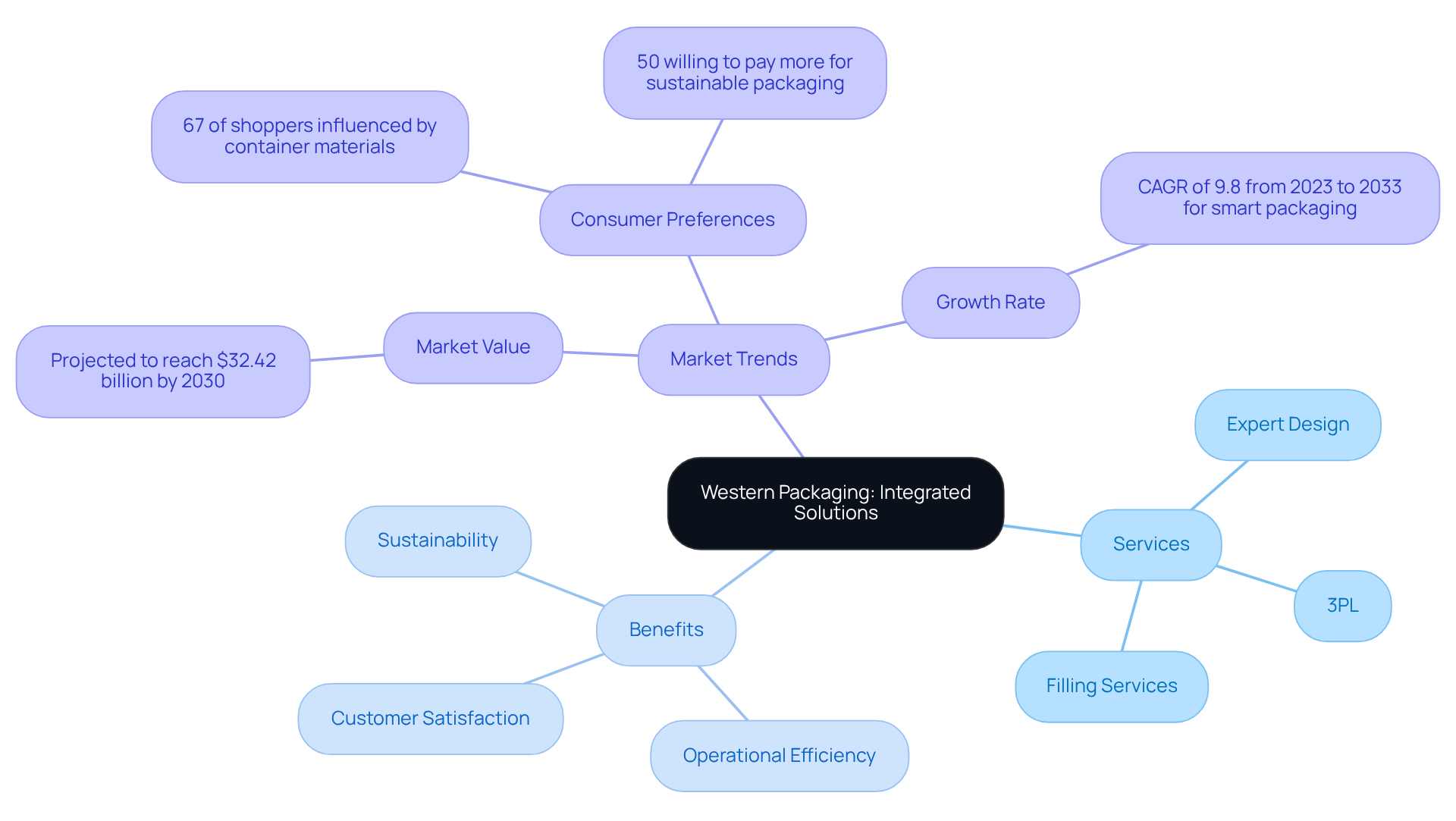
Plant-Based Plastics: Sustainable Alternatives for Eco-Friendly Packaging
Plastics derived from renewable sources such as cornstarch, sugarcane, and algae are emerging as viable eco-friendly substitutes for conventional petroleum-based plastics. These innovative materials not only diminish reliance on fossil fuels but also deliver comparable performance attributes, making them suitable for a wide array of applications.
Companies that embrace plant-based plastics can effectively cater to the growing demographic of environmentally conscious consumers, thereby enhancing their brand reputation and market presence. As regulatory frameworks surrounding plastic usage become increasingly stringent, transitioning to plant-based options strategically positions businesses, ensuring compliance while appealing to a sustainability-driven market.
The plant-based container market is anticipated to reach USD 19.9 billion by 2035, reflecting a compound annual growth rate of 6.7%, which underscores the rising demand for sustainable solutions. This shift not only addresses consumer preferences but also aligns with broader environmental goals, making plant-based plastics a strategic choice for forward-thinking companies.
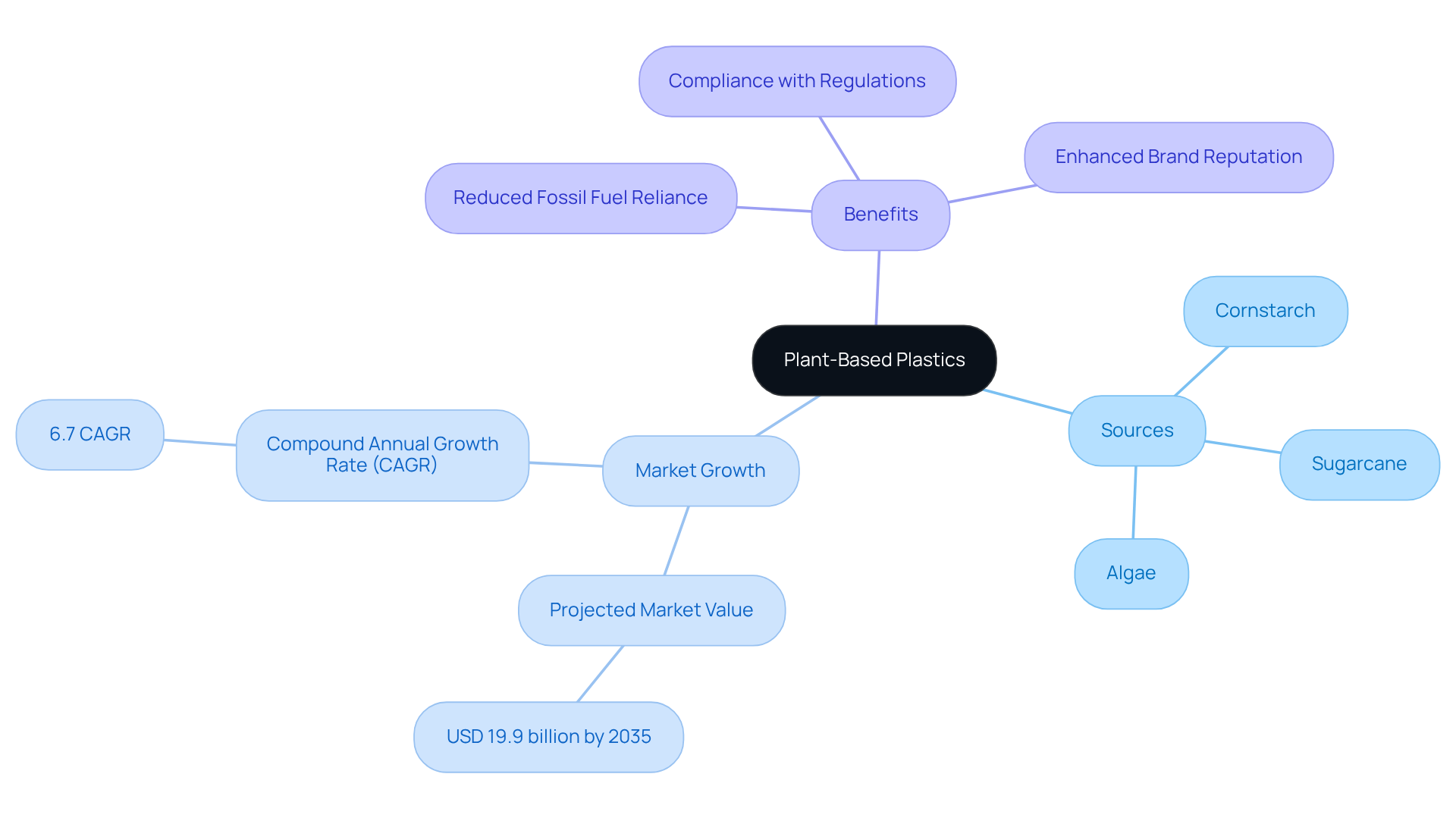
Mushroom-Based Packaging: Biodegradable Solutions for a Greener Future
Mushroom-derived solutions, crafted from mycelium and agricultural waste, present a fully biodegradable alternative to conventional materials like polystyrene. This packaging innovation not only tackles the pressing issue of plastic waste but also utilizes renewable resources, thereby establishing itself as an environmentally responsible choice. The production process is notably energy-efficient, and these materials can be composted at home, thereby reinforcing the principles of a circular economy.
As businesses increasingly prioritize sustainability, mushroom-based materials stand out as a compelling option that aligns with consumer demand for eco-friendly products. The global mushroom container market was valued at USD 62.08 million in 2023 and is projected to reach approximately $118.63 million by 2032, reflecting a compound annual growth rate (CAGR) of roughly 7.46% from 2024 to 2032.
Experts assert that advancements in biodegradable materials, particularly those utilizing mycelium, are essential for packaging innovation that diminishes environmental impact and promotes a sustainable future. As Robert Swan poignantly stated, 'The greatest threat to our planet is the belief that someone else will save it,' underscoring the necessity for proactive measures in sustainability.
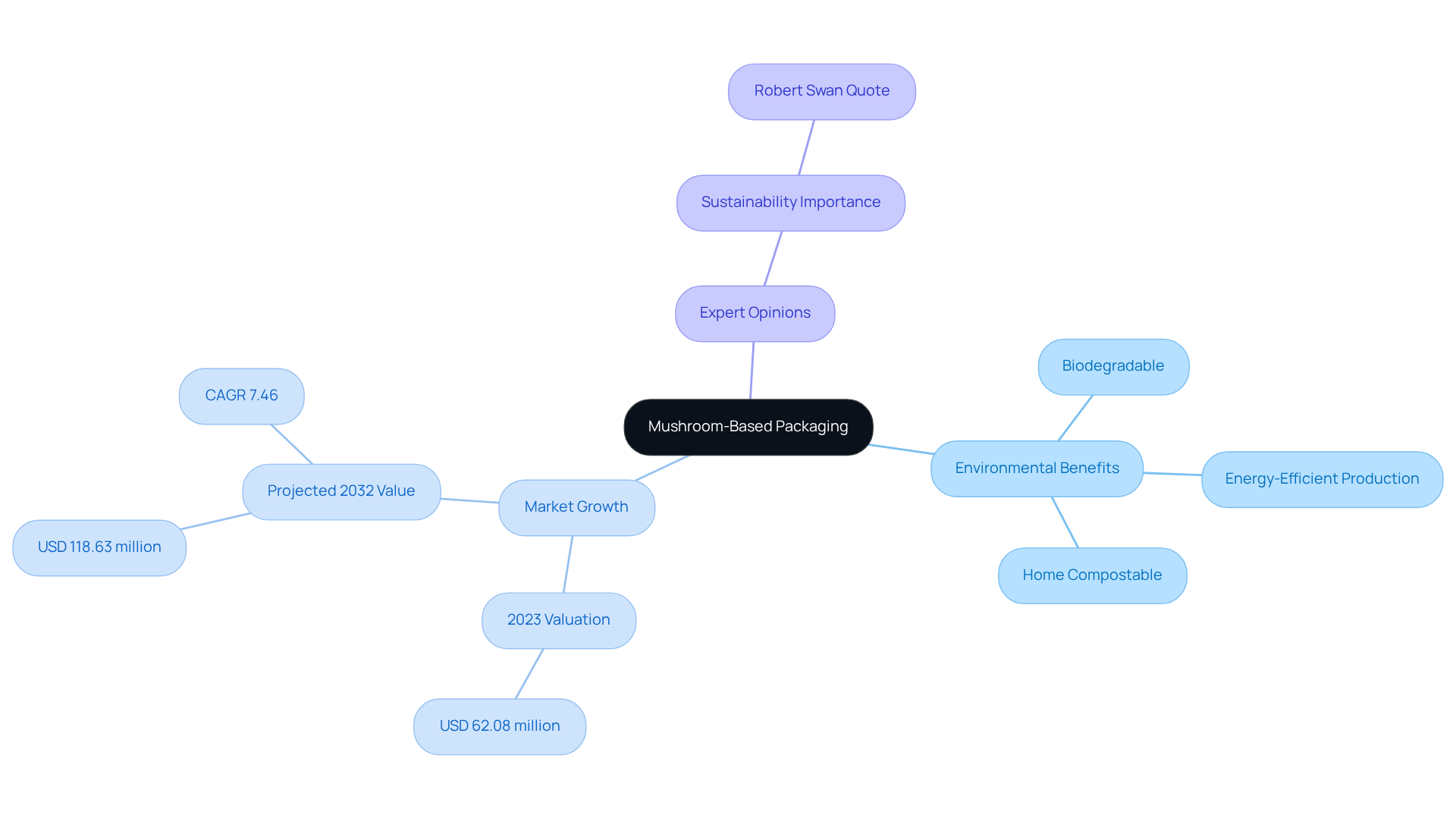
Blockchain-Integrated Smart Packaging: Enhancing Traceability and Transparency
Blockchain-integrated smart packaging employs advanced technology to create an immutable record of a product's journey from production to end user. By incorporating QR codes or NFC tags, brands can provide consumers with real-time access to critical information regarding product sourcing, manufacturing processes, and supply chain practices. This heightened transparency not only fosters trust among consumers but also aids brands in meeting regulatory requirements.
As sustainability emerges as a vital concern for consumers, the adoption of blockchain technology reinforces a brand's commitment to ethical practices and environmental stewardship. Notably, 70% of shoppers report that packaging influences their purchasing decisions, underscoring the importance of transparent containers in cultivating brand loyalty.
As companies increasingly prioritize traceability, packaging innovation through the integration of blockchain becomes essential for maintaining product integrity and enhancing consumer engagement. Furthermore, the blockchain-integrated smart packaging market is anticipated to expand from USD 19,420 million in 2024 to USD 26,989.2 million by 2032, highlighting a significant trend that nutraceutical manufacturers must consider.
Nevertheless, challenges such as high implementation costs and interoperability issues remain critical hurdles that companies need to navigate.
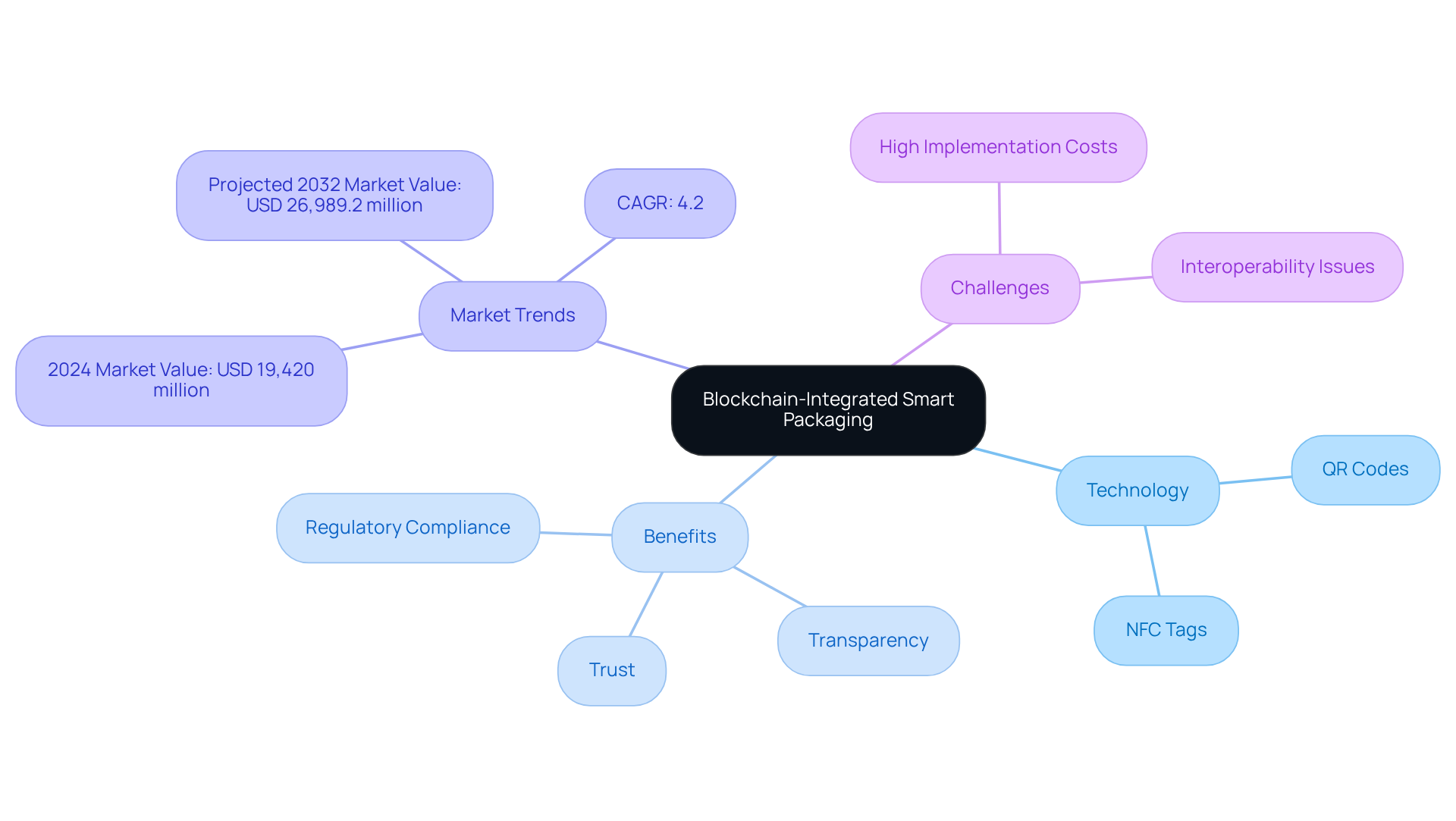
Reusable Packaging Systems: Reducing Waste and Promoting Sustainability
Reusable container systems are engineered for multiple uses, significantly mitigating waste generated from single-use alternatives. These systems include containers, crates, and pallets that are returned, sanitized, and reused within a closed-loop supply chain. By embracing reusable containers, companies can drastically lessen their ecological footprint, reduce costs associated with materials, and meet public expectations for sustainability.
For example, in 2023, 63% of Nestlé's plastic containers were reusable, recyclable, or compostable, and major corporations like Danone have similarly reported commitments, reflecting a broader industry trend toward sustainable practices. Furthermore, the adoption of these systems not only fosters brand loyalty—especially as 58% of global consumers strive to minimize excess product materials for sustainability—but also enhances operational efficiency.
As sustainability advocates assert, the transition to reusable containers is not merely a trend but an essential evolution in responsible business practices. Over time, the cost-per-use of reusable resources declines, making them a financially attractive option for companies.
To effectively implement reusable container systems, organizations should consider initiating a pilot program to evaluate feasibility and gather data on cost savings and environmental impact.
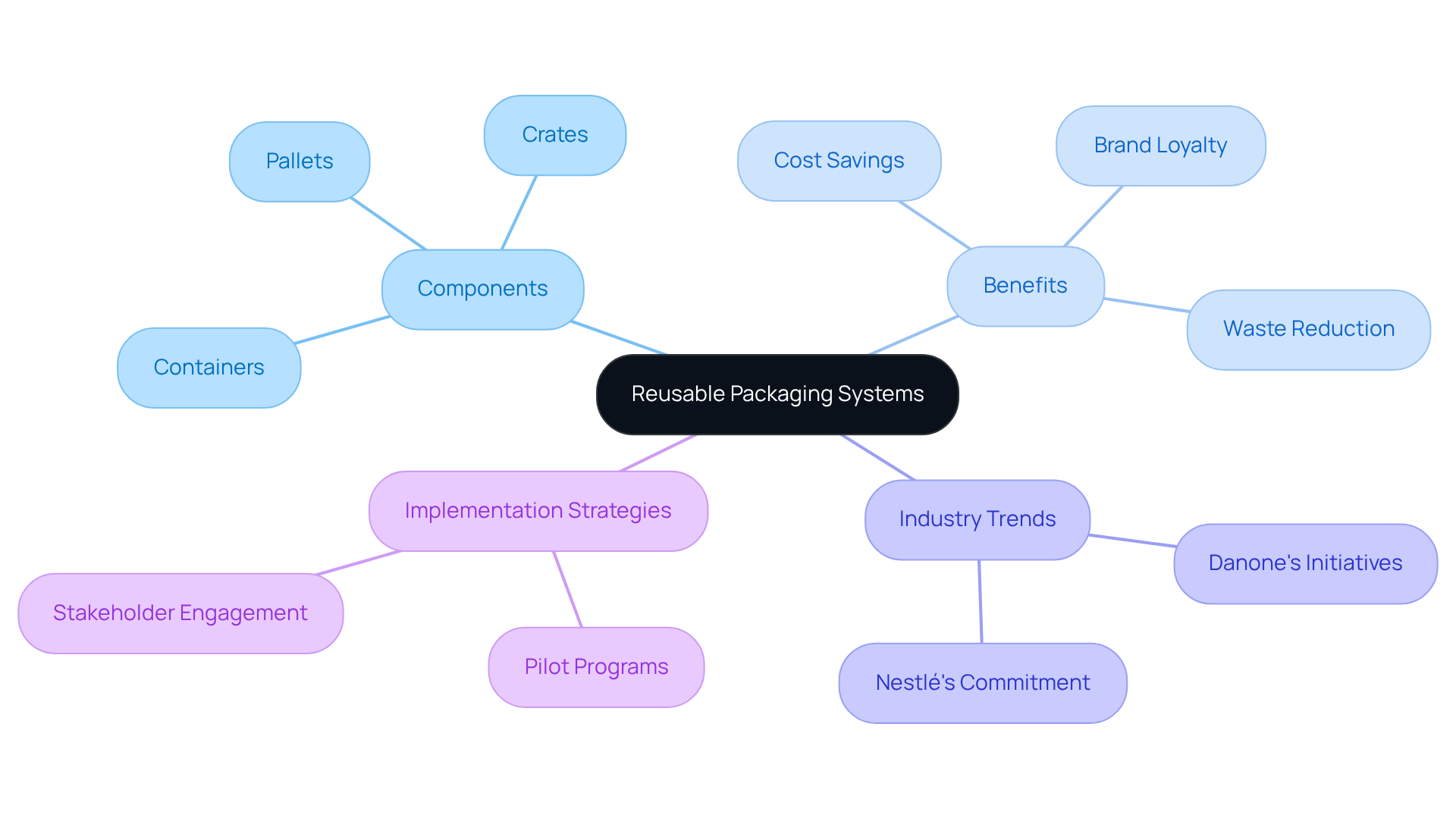
Seaweed-Based Packaging: Harnessing Nature for Sustainable Solutions
Seaweed-based solutions are rapidly emerging as a viable alternative to conventional plastics, harnessing the inherent qualities of seaweed to produce biodegradable and compostable materials. This innovative strategy addresses the urgent challenge of plastic waste while utilizing a renewable resource that requires minimal land and water for cultivation.
The demand for seaweed containers spans various industries, particularly in food packaging and disposable products, showcasing packaging innovation that offers an eco-conscious option to meet the increasing consumer preference for environmentally friendly solutions. As the market for sustainable supplies expands, seaweed-derived alternatives are poised to attract significant attention from companies committed to environmental stewardship.
Recent advancements in this domain include the creation of antimicrobial seaweed wraps, which not only prolong product shelf life but also mitigate food waste, exemplifying the dual benefits of sustainability and functionality. Moreover, environmental scientists highlight that seaweed's capacity to sequester carbon and its minimal ecological footprint position it as a superior choice compared to traditional plastics, underscoring its pivotal role in the shift towards a more sustainable future.
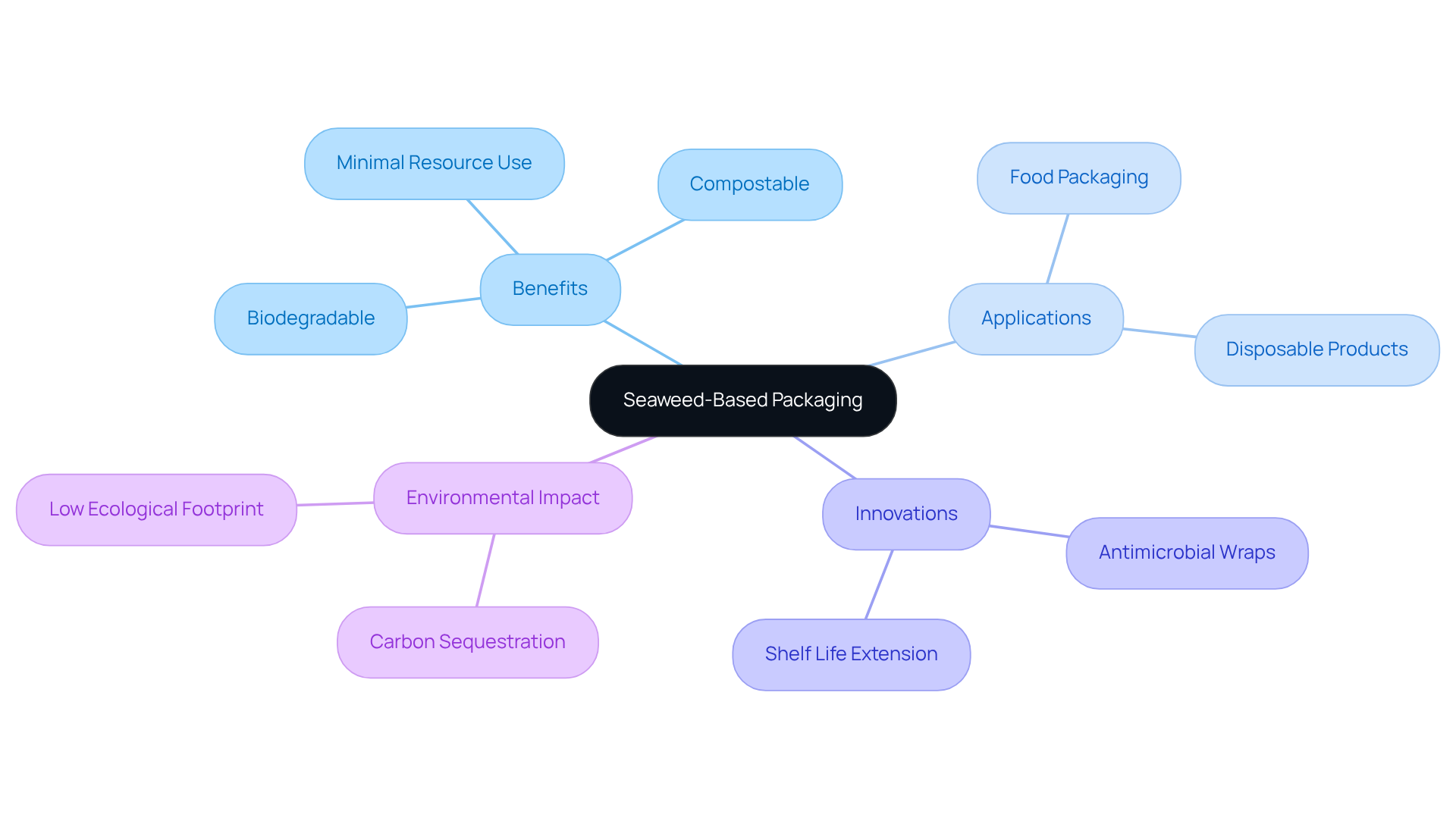
Paper-Based Packaging Solutions: Eco-Friendly Alternatives to Plastic
Paper-based solutions are increasingly recognized as eco-friendly alternatives to plastic, offering significant advantages such as biodegradability and recyclability. The global paper container market, valued at over USD 410.5 billion in 2024, is projected to grow to USD 596.5 billion by 2034, reflecting a CAGR of 3.8%. This growth is driven by packaging innovation that enhances functionality while maintaining sustainability. Recent advancements, including improved barrier coatings and lightweight designs, not only preserve product integrity but also minimize material usage.
Brands transitioning to paper containers are successfully appealing to environmentally conscious consumers. Studies reveal that 51% of grocery products currently utilizing plastic could be replaced with more sustainable options. A notable example is Pringles, which recently launched a new crisp container made from recycled paper, highlighting its commitment to reducing plastic waste. Additionally, Mondi's introduction of 'TrayWrap,' a paper-based solution designed to replace plastic shrink film, along with Saica Group's partnership with Mondelēz to develop recyclable paper-based materials for multipacks, exemplifies the growing trend of brands adopting paper alternatives. As regulations surrounding plastic usage tighten, the shift towards paper-based solutions enables businesses to align with sustainability objectives while enhancing their market presence.
Industry leaders emphasize the critical role of packaging innovation in this sector. Ginni Rometty, former CEO of IBM, asserts that growth and comfort are not compatible, urging companies to confront new challenges. This perspective is essential as the paper container industry adapts to meet consumer demands and regulatory pressures, ultimately leading to a substantial reduction in environmental impact.
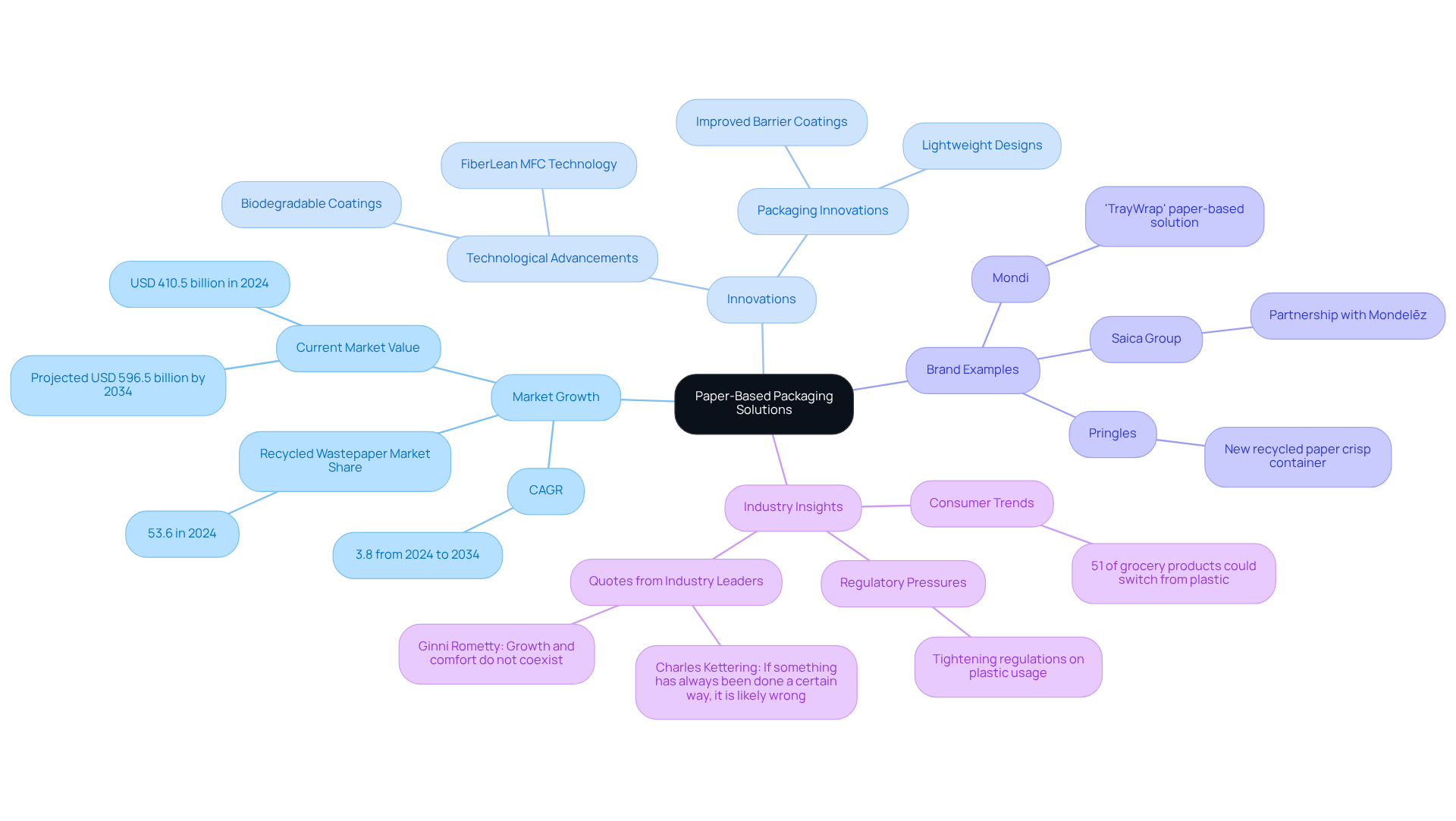
Renewable Material Packaging: Supporting a Circular Economy
Renewable resource containers leverage assets that are naturally replenished, including bioplastics derived from plant materials and recycled paper products. By integrating these sustainable resources into design concepts, companies can significantly diminish their carbon footprint and mitigate environmental impact. This approach not only bolsters sustainability initiatives but also resonates with consumer preferences for eco-friendly products; indeed, 77 percent of North American respondents affirm the sustainability of compostable and plant-based materials.
As businesses navigate regulatory frameworks and evolving consumer expectations, the adoption of renewable resource containers emerges as a vital component in enhancing brand reputation and securing a competitive edge in the marketplace. Furthermore, the use of bioplastics and recycled materials aligns with the principles of a circular economy, fostering resource efficiency and waste reduction.
Successful implementations of these materials in design underscore their viability and effectiveness, showcasing a commitment to eco-friendly practices that appeal to environmentally conscious consumers. For instance, companies that have adopted bioplastics have reported substantial reductions in their overall ecological footprint, highlighting the economic significance of this transition, as the eco-friendly materials market is projected to surpass 270 billion dollars by 2024.
To initiate packaging innovation by incorporating renewable materials into packaging processes, businesses should begin by evaluating their current resources and pursuing partnerships with suppliers who prioritize eco-friendly options.
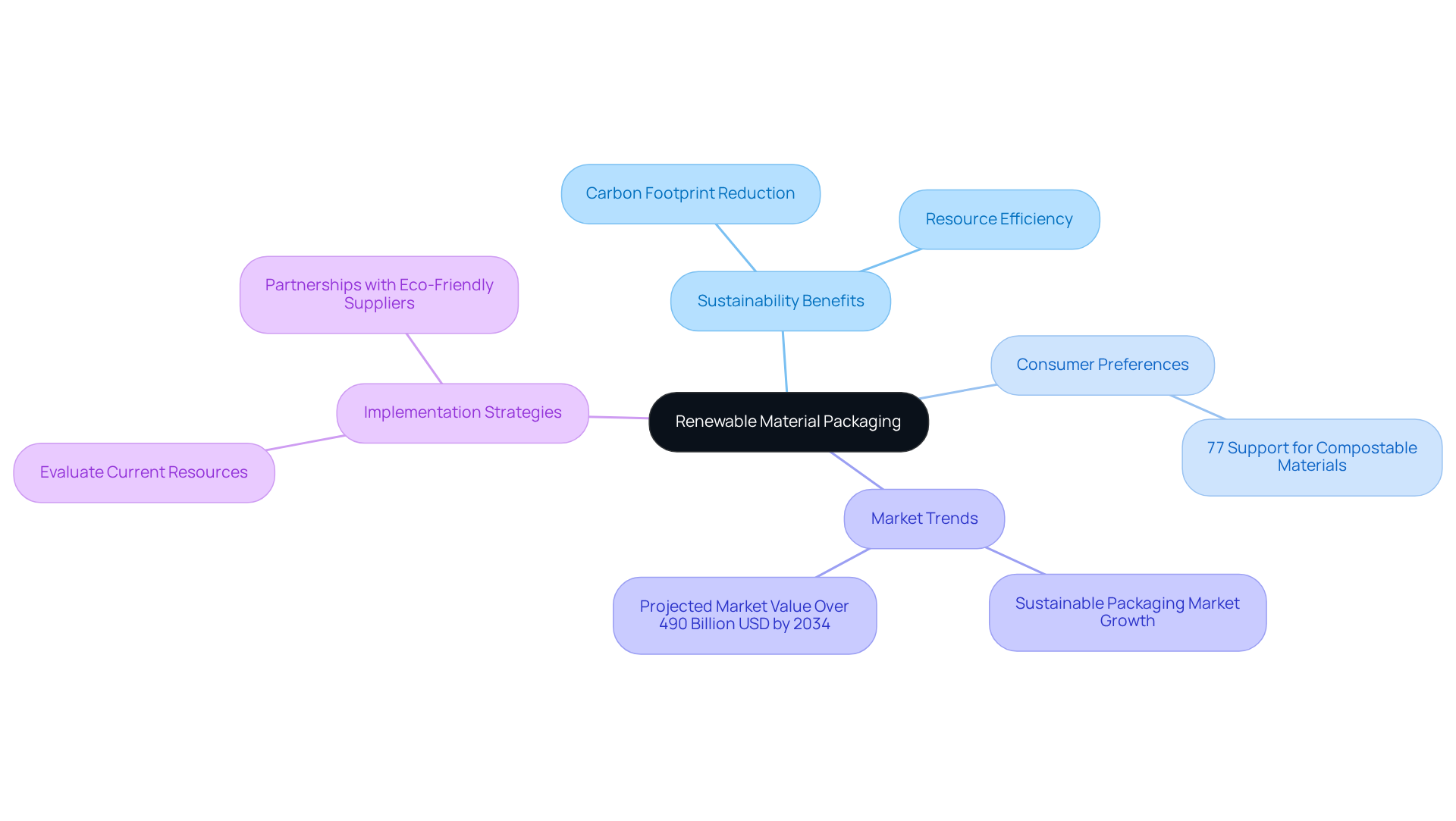
Plastic-Free Cosmetic Packaging: Innovations for Eco-Conscious Beauty
The cosmetics sector is experiencing a significant transformation due to packaging innovation as it shifts towards plastic-free containers, driven by public demand for sustainable and eco-friendly products. Packaging innovation through materials such as glass, metal, and biodegradable alternatives is reshaping the beauty product landscape.
Brands that embrace packaging innovation by adopting plastic-free solutions not only diminish their ecological footprint but also enhance their appeal to environmentally conscious consumers. Notably, consumers are willing to pay an average of 9.7% more for eco-friendly products, underscoring the financial benefits of adopting sustainable practices.
By prioritizing sustainability in their designs, cosmetic brands can foster brand loyalty and effectively distinguish themselves in a competitive marketplace. This trend is underscored by industry leaders like Emma Bailey, who assert that packaging innovation towards environmentally friendly solutions is not merely a trend but a necessity for brands aiming to remain relevant and impactful in an increasingly eco-aware market.
Furthermore, the cosmetics industry generates a substantial volume of waste annually, amplifying the need for eco-friendly container solutions. Successful examples, such as RMS Beauty's shift to 100% post-consumer recycled plastic for product lids, demonstrate the potential for brands to lead in sustainability while addressing these urgent challenges.

100% Recyclable Ketchup Cap: Small Innovations with Big Impact
Kraft Heinz's introduction of the first 100% recyclable ketchup cap signifies a significant packaging innovation in eco-friendly containers within the food industry. This packaging innovation not only improves the recyclability of the entire ketchup bottle but also supports the company's ambitious goal of ensuring all containers are recyclable, reusable, or compostable by 2025.
Such seemingly minor yet transformative changes in container design through packaging innovation can lead to substantial reductions in plastic waste, fostering a more sustainable future. In fact, wrappers and containers accounted for 28.1% of total waste produced in the U.S., underscoring the critical need for packaging innovation like the recyclable ketchup cap.
As public demand for environmentally responsible brands continues to rise, packaging innovation not only enhances brand loyalty but also strengthens market presence. Notably, 82% of consumers are willing to pay extra for items with eco-friendly packaging, highlighting the potential for minor packaging innovation to yield considerable impacts in the packaging sector.
As Haley Seiberlich points out, "Clear communication from brands regarding their material usage, sourcing practices, and end-of-life options is also important." This emphasizes the necessity for brands to not only innovate but also effectively communicate their sustainability efforts.
Furthermore, the market for sustainable packaging innovation is projected to grow from USD 292.71 billion in 2024 to USD 423.56 billion by 2029, reflecting the increasing relevance and demand for sustainable solutions in the industry.

Conclusion
The exploration of innovative packaging strategies underscores the urgent need for sustainable solutions in today’s market. By embracing a variety of approaches—from integrated services and plant-based alternatives to biodegradable materials and smart technologies—companies can significantly enhance their operational efficiency while fulfilling consumer demands for eco-friendly practices.
Key insights illustrate the growing importance of sustainable packaging innovations. Market projections indicate substantial growth in sectors such as plant-based plastics, mushroom-based solutions, and reusable systems, positioning businesses to adapt and thrive in an increasingly environmentally conscious landscape. Furthermore, advancements in blockchain technology and paper-based alternatives showcase the potential for transparency and functionality to coexist, ultimately fostering brand loyalty and consumer trust.
In light of these trends, it is imperative for businesses to actively engage in sustainable packaging practices. By prioritizing innovation and embracing eco-friendly materials, companies not only contribute to a healthier planet but also align themselves with the evolving expectations of consumers. Taking proactive steps toward sustainability is not merely a trend; it is a necessary evolution that can lead to lasting impact and success in a competitive marketplace.
Frequently Asked Questions
What services does Western Packaging offer?
Western Packaging provides a comprehensive suite of services, including expert design, filling services, and robust third-party logistics (3PL), aimed at enhancing packaging efficiency.
How does Western Packaging's integrated approach benefit clients?
By unifying various services, Western Packaging streamlines the supply chain, reduces lead times, and allows clients to focus on their core strengths while receiving personalized solutions tailored to their needs.
Which industries benefit most from Western Packaging's services?
Manufacturers and distributors in sectors such as nutraceuticals, food and beverage, and goods benefit significantly from Western Packaging's integrated services.
What is the projected market value for eco-friendly packaging solutions by 2030?
The market for eco-friendly solutions and packaging innovation is projected to reach a value of $32.42 billion by 2030.
How do container materials influence consumer purchasing decisions?
Approximately 67% of American shoppers indicate that container materials impact their purchasing decisions, emphasizing the importance of effective packaging in brand loyalty.
What is the expected growth rate for the innovative container market from 2023 to 2033?
The innovative container market is anticipated to expand at a compound annual growth rate (CAGR) of 9.8% from 2023 to 2033.
What are plant-based plastics, and why are they important?
Plant-based plastics are derived from renewable sources such as cornstarch, sugarcane, and algae, serving as eco-friendly alternatives to conventional plastics. They help reduce reliance on fossil fuels and appeal to environmentally conscious consumers.
What is the projected market value for the plant-based container market by 2035?
The plant-based container market is expected to reach USD 19.9 billion by 2035, reflecting a CAGR of 6.7%.
What are mushroom-based packaging solutions, and what advantages do they offer?
Mushroom-based packaging is made from mycelium and agricultural waste, providing a fully biodegradable alternative to conventional materials. They are energy-efficient to produce and can be composted at home, supporting a circular economy.
What is the projected growth for the global mushroom container market?
The global mushroom container market was valued at USD 62.08 million in 2023 and is projected to reach approximately $118.63 million by 2032, with a CAGR of roughly 7.46% from 2024 to 2032.




